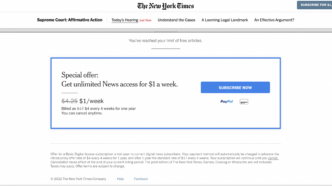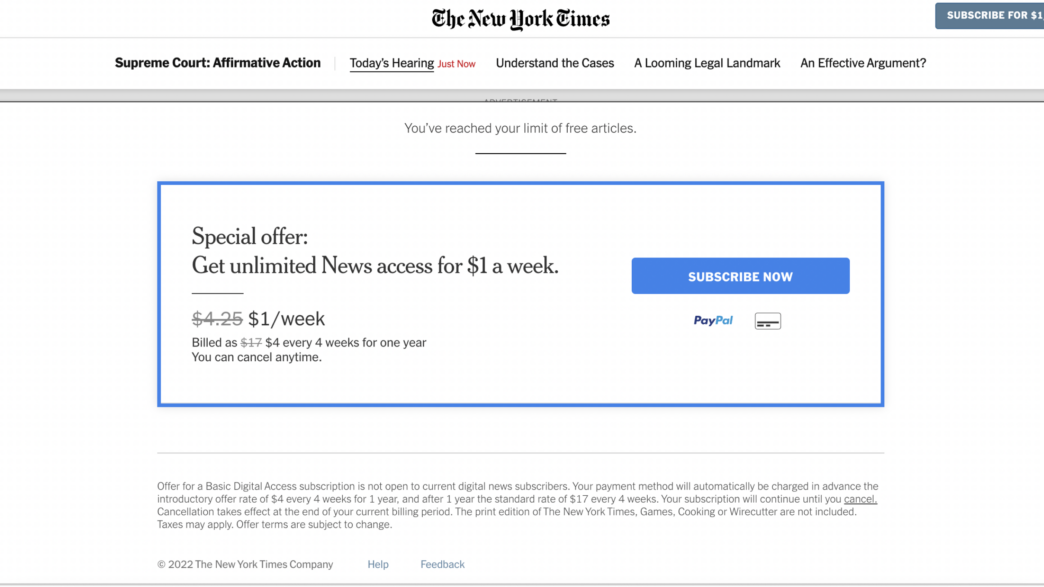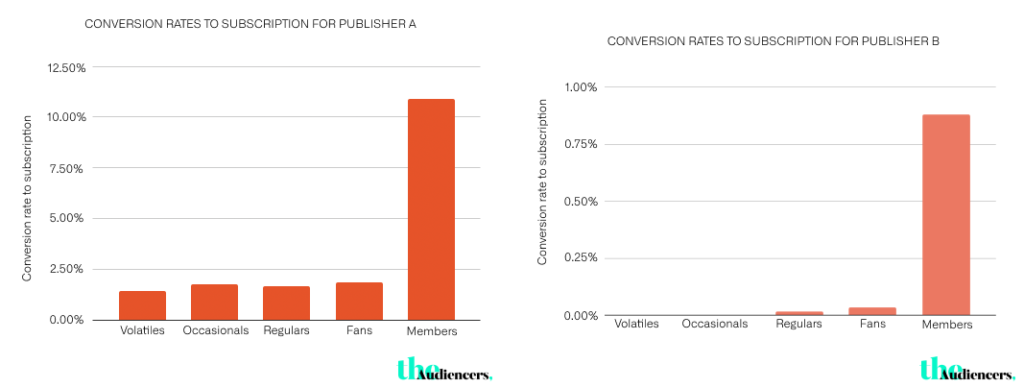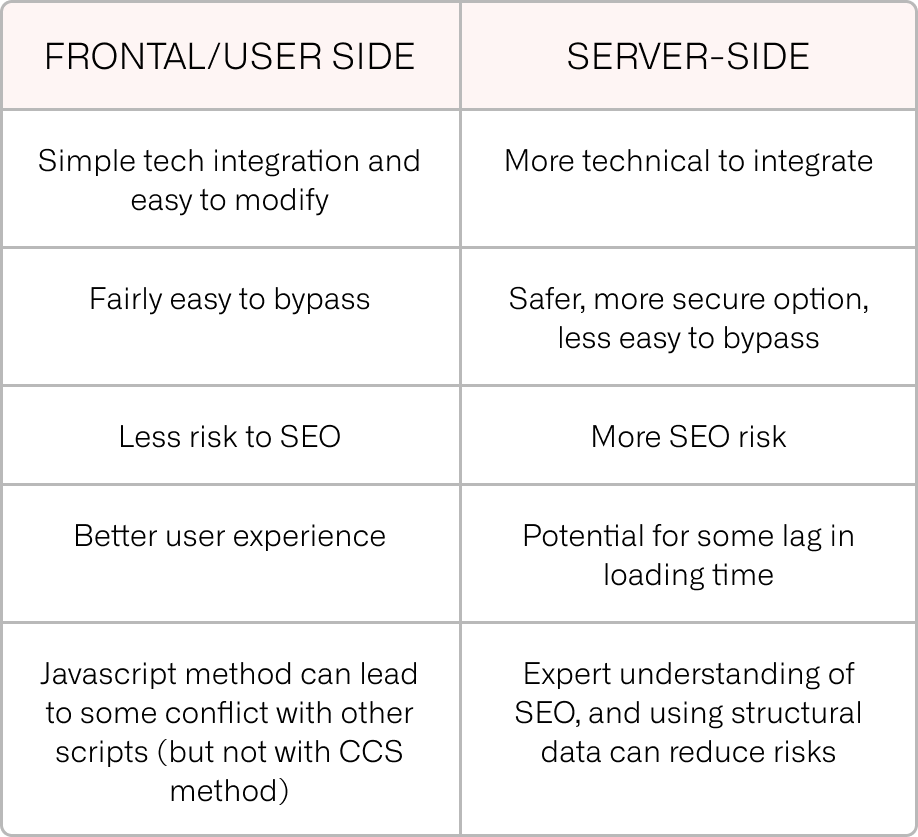

We take a closer look at arguably the most famous digital subscription publisher in the world, studying their dynamic model, paywall blocking method and uncovering key takeaways to apply to your own strategy.
In brief: - The NYT has developed a dynamic metered model that’s optimized for two metrics simultaneously - engagement and conversion to subscription - Although this model is complex and not something that every publisher can afford to build in-house, there are lessons to be learned - Registration as a soft conversion step, developing numerous levers for value creation and not worrying too much about bypassing are just some of the strategies you can apply to your own digital model
In the beginning…
Back in March 2011, The New York Times did something that very few dared to do at the time. They blocked content online with a paywall.
“5 Reasons Why The New York Times Paywall Will Fail (And Why It’s Really Dumb)”
“The New York Times’ paywall is doomed to fail”
*There were likely plenty more opinions like the above at the time but, let’s be honest, they’ve likely changed their mind since!
Whatever people’s views on the matter, The New York Times was facing a crisis – ad revenue in freefall, income from print at an all time low, and online content disrupting the news business. It was time for a digital transformation. The start of a process to become subscription-first.
At the start, The New York Times employed a metered strategy whereby readers could access a quota of 20 free articles a month before being blocked by the paywall. The idea here was that traffic from occasional visitors could be maintained, whilst more engaged readers would hit the article limit and be encouraged to subscribe.
This is the value in a metered paywall model – you allow for content discovery and engagement prior to presenting the paywall, helping to find the balance between frustration and engagement.
Today is a very different story for The New York Times…
After acquiring The Athletic, The New York Times achieved its 2025 goal of 10 million subscribers a few years early, in February 2022, setting a new target of 15 million by 2027.
The question then turns to how.
How have the NYT gone from employing a ‘doomed’ strategy to running a successful premium model with over 10 million subscribers?
According to Rohit Supekar, Data Analyst at the NYT, there are two central reasons for this success:
- Continuous testing, improvement and development of their premium strategy over the years
- But, most importantly, the publisher has moved from a one-size-fits-all approach to a dynamic metered model, driven by data
I.e. The New York Times paywall personalizes the meter limit to the reader.
Dynamic metering at The New York Times
The engagement funnel towards subscription is composed of 3 stages:
- Unregistered, anonymous users arrive on the site and are presented with x number of free articles.
- After reaching this limit, the user is blocked by a registration wall and asked to create a free account in exchange for access to additional articles.
- Thanks to registration, activity can now be linked to the user’s custom reader ID with data being collected to help the publisher better understand this user’s current appetite for the NYT content. With this information, the dynamic model offers x number of free articles before presenting the paywall – x being a number that is determined optimal based on the registered user’s level of engagement.
How does this dynamic model work?
This dynamic paywall strategy has been optimized for two metrics simultaneously. Specifically:
- Reader engagement
- The number of subscription generated by the paywall
As usual for any conversion strategy, it’s about balancing frustration and engagement.
Increase the meter limit and your users will be more engaged. However, fewer readers will reach the paywall and be frustrated enough to convert.
Conversely, if you keep the meter limit too low, you may have more registered members being exposed to the paywall, but these users haven’t been engaged enough to want to convert – i.e. too much frustration.
Engagement is valuable and you should continuously seek to increase it.
But the right amount of frustration is what’s going to encourage conversions and turn engagement into revenue.
To find this balance, the model prescribes meter limits from a set of options, taking into consideration the user’s propensity to subscribe and their level of engagement.
What can you take away from The New York Times’ dynamic paywall model?
Nor everyone is as big as The NYT (that’s for certain) and developing this dynamic model in-house is pretty inaccessible for most publishers. Having said this, there are lessons to be learned to apply to your own strategy.
1. Registration as a soft conversion step
Registration (free account creation) has been a great asset to the publisher’s subscription acquisition efforts, increasing conversion rates by more than 40% according to The New York Times 2022 annual report.
But the NYT aren’t the only ones to benefit from this strategy – in fact, increasingly more publishers of all sizes are seeing the benefits of this soft conversion step prior to the paywall.
For instance, the data below from two of Poool’s clients demonstrates the huge increase in conversion rates for registered members compared to anonymous visitors.

This didn’t require an expensive in-house model. Instead, the publishers segmented their audience based on level of engagement to build conversion journeys that found the best balance between frustration and engagement.
Paris Match, for instance, presents less engaged users with a registration wall to help them discover more content and collect data to better understand their behavior. For ‘Fan’ readers however, who are highly more engaged, a hard paywall blocks content and requires them to subscribe.
How to fully maximize registration – The NYT not only registers their users, but also leads them through an onboarding journey to increase engagement, such as encouraging newsletter sign-up and app downloads, just as they’d do with new subscribers.
2. Develop multiple levers for value creation
Whilst a subscription model will bring the most value to your business, you can do like the New York Times and establish numerous, synergistic revenue streams that seek to gradually increase customer lifetime monetization.
Anonymous users – for readers that have just arrived on your site (or are yet to create an account), you can firstly ensure that they accept cookies and then monetize from advertising.
Registered members – product driven engagement and first-party data collection will mean registered users support both ad and subscription revenue streams.
Single product subscribers – recurring, predictable revenue stream from your subscribers is what’s going to bring the most value. However, the key is to put significant time and effort into churn reduction to maximize customer lifetime value.
Bundle and multi-product subscribers – (full access to two or more digital products) with bundles, publishers can increase conversion and retention rates by providing a wider variety of value under a single umbrella.
3. Bypassing isn’t all that bad, there’s other things to think about
To give context to this point, The New York Times employs a frontal paywall blocking method, meaning that it’s fairly simple to bypass their wall.
This begs the question of why one of the most successful digital publishers would employ a blocking method that results in an easy-to-bypass wall?
In fact, the answer is quite simple – because there’s a lot more at stake when it comes to paywall blocking methods and other factors are more important to consider than bypassing.
For instance, frontal blocking methods pose significantly less risk to SEO performance as all content is sent to the page, whether the user has access or not.

What’s more, it’s worth bearing in mind that the users who do bypass your paywall are perhaps never likely to subscribe anyway. Instead, you should focus on the most important segment of your audience – those who are the most engaged and wouldn’t bypass your paywall anyway. These are your most valuable resource and, by employing a flexible model that performs well in terms of SEO and user experience, you can maximize the value that they bring to your business.












